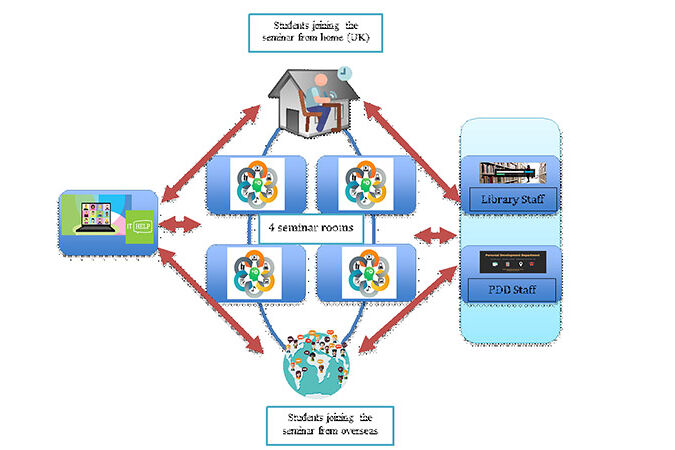Making and breaking chains is the first in a blog sequence examining the domestic everyday of education activism in the collapsed home under COVID.
This is the first in a short series of linking blogs forming the pilot study for my education doctorate. The aim of the pilot is to use rhythmanalysis (Lefebvre, 1992) as a methodology to investigate the domestic everyday of education activism and organising, in order to imagine and engage with future education activism and organising, the future “university/education-space”, and the relationship between these. The purpose of this first blog is to introduce the lived context and aims of the pilot study: to identify and clarify the key tasks the blog series will undertake.
For this pilot, I aim to analyse the rhythms and disruptions of chainmaking (past, current, and future-possible) to explore the conflicting process of building connections of resistance under the restrictions of the state. I am structuring this in the form of blogs as initial links for further development as my research progresses and also hopefully opportunities for interconnection with responses as a form of cybernetic collectivism (Shanken, 2003).
My starting point for this is the collapsed, layered labour space of the household under COVID. The chainmaking taking place in my household includes trade-union activism; the forging and strengthening of connections between workers to create collective strength around class interest. It includes radical education work; the linking together of the personal lived political world and the overarching structures of theory/analysis, as centred by hooks (1994) and Freire (1970). It also includes mothering and other housework; the construction and maintenance of links between dependents and “society”, which is presented as natural but is the labour of connection building and material and emotional maintenance all the same.
The term chainmaking is an echo in part from 1910. The Cradley Heath chainmakers occupy a position of significance as women workers who disrupted industry in the Black Country and were part of the catalyst of wider revolt in the early 20thcentury (Barnsley, 2011). The chain is also a pertinent symbol to wrestle with the problems, tensions and boundaries of collectivism and resistance under the state which are central to my research, teaching, activism and domestic labour. It makes visible the extent to which critique, organising and resistance to capitalism must acknowledge capitalism as global, colonial and racial in its past, present and future (Robinson, 2019; Bhattacharyya, 2017). While the women strikers worked on smaller chain, they were not in a vacuum and the wider industry they disrupted but have also been used to commemorate created chain for slavery (Green, 2008).
For Chen (2017), rhythmanalysis roams around disciplines, looking for repetitions, allowing for a heightening of lived experience. It could be suggested that the everyday domestic has been fundamentally neglected as an organising space, even if there are numerous academic works across different disciplines that analyse the domestic sphere. Lefebvre (1991), like Marx, identifies a need to do as well as see. The roaming around of rhythmanalysis seems suitable for the fluid, layered task of undertaking research as a student whilst engaged in the work of a trade union officer/mother/domestic labourer/activist.
The household is a site of the everyday. For Lefebvre (1991), the everyday has been neglected by much Marxist analysis but its interrogation and critique is crucial in understanding and tackling alienation, reaching for not abolition of wealth but abundance and universal access to wealth. For Marxist feminists including Federici (2020) and D’Atri (2021) the everyday of the home is a crucial and neglected organising site to deliver the unmet demand of “not only bread but also roses” in the defeat of capitalism. Rhythmanalysis as a multi-sensory tempero-spatial engagement with the mundane considers the gaps left by a focus on the extraordinary, the cracks through which the future-possible can be accessed. My approach to the (domestic) everyday is framed through Marxist feminism: as Carpenter and Mojab (2017) note, Marxist feminism provides a framework for inquiry for radical educators,
“a way of looking at how the social world and everyday/everynight experience is organised through the everyday activity of people and a way of understanding how certain forms of knowledge come to dominate not only our consciousness but our activity and forms of social organisation as well.” (74).
The everyday exists in the mundane and the mundane exists in and tells us about the broader ways in which race, capital and gender act as sites of power to organise our activities. My framework as a Marxist feminist sees race, racism and colonialism as central to and intertwined with the capitalist project, rather than a sub-strand to class and gender. Race and racism are seams that run through my everyday: the state, the home, the community. I am interested in learning from intersectional feminism past and present but do not take that term to define what I am trying to do as a researcher, perhaps because it appears to be increasingly commandeered by a white liberal feminist approach to the problems of race, gender and class.
Potentially, a liberal feminist academic approach calling itself intersectional can include accumulating capital (whether cultural or material) from “white allyship” as a commodity which can be sold through training or accumulated through a competitive process of mutual-policing-as-solidarity. In this use, a commandeered “intersectionality” increasingly distances the matters of class, capitalism and collectivism from the centre of analysis in favour of individual self-betterment and as such for white education workers like myself could easily pull work towards such a project; something counter to collective struggle.
Using rhythmanalysis to interpret chainmaking as a rhythm of repetitions, I will consider previous iterations of organising in domestic labour-spaces and how they relate to, frame and give guidance for the present and future of education organising. For the pilot study, I am looking in particular at the Cradley Heath chainmakers strike of 1910, including Barnsley’s research, the 1975 television documentary Nothing to Lose: the women chainmakers strike of 1910, Cradley Heath, and online archives from the Modern Records Centre (MRC) at the University of Warwick. The chainmakers were women who worked primarily in the “hearth industry”: in the home, often with multiple tasks of caring for younger children or disabled relatives and training older children (MRC, 2021) who were able to collectively disrupt the rhythm of their working world to win the first UK minimum wage. The chainmakers revolt is interesting in many ways, including the forging of solidarity in conditions in which workers were not historically well organised, were isolated, and were pitched against one another (Barnsley, 2011). What can this previous disruption reveal in terms of the ideas and problems this disruption exposed can be forged into the current and future organising challenges for education activists organising in and out of COVID?
In the blog sequence I intend to use the moment of the chainmakers strike and the process of chainmaking to consider the following key challenges as starting links for the body of my main thesis:
- Interrogating the domestic: COVID & the collapsed home
- The home, class and education.
- Arrhythmia: breaking chains
- Pandemic pinch-point: invisible domestic labour
- Chainmaking: forging the future?
References:
- Barnsley, T. (2011). Mary Macarthur and the Chainmakers’ strike of 1910. London: Bookmarks
- Bhattacharyya, G. (2017). Rethinking racial capitalism: questions of reproduction and survival. London: Rowman and Littlefield
- Carpenter, S., and Mojab, S. (2017). Revolutionary learning: Marxism, feminism and knowledge (3rd edition). London: Pluto Press.
- Chen, Y. (2017). Practicing Rhythmanalysis: theories and methodologies. London: Rowman and Littlefield
- D’Atri, A. (2021) Bread and Roses: gender and class under capitalism (3rd edition). London: Pluto Press
- Federici, S. (2020). Revolution at point zero: housework, reproduction and feminist struggle (2nd edition). Toronto: Between the Lines books.
- Freire, P. (1970). Pedagogy of the oppressed. London: Continuum.
- Green, A. (2008) Remembering slavery in Birmingham: sculpture, paintings and instillations. Slavery and abolition: a journal of slave and post-slave studies, 29 (2)
- hooks, b. (1994). Teaching to transgress. Abingdon: Routledge.
- Lefebvre, H. (1991) The critique of everyday life London: Verso (trans. John Moore: originally published 1947)
- Lefebvre, H. (1992) Rhythmanalysis. London and New York: Continuum.
- Modern Records Centre. 1910. Women slaves of the forge. [Press cutting] University of Warwick, Work in the sweated trades, 1910s – 1920s. Coventry.
- Robinson, C. J. (2019) On racial capitalism, Black internationalism, and cultures of resistance London: Pluto Press
- Shanken, E. A. (2003). From Cybernetics to Telematics: The Art, Pedagogy, and Theory of Roy Ascott. In: E. A. Shanken (ed.) Telematic Embrace: Visionary Theories of Art, Technology and Consciousness. Berkeley: University of California Press.





